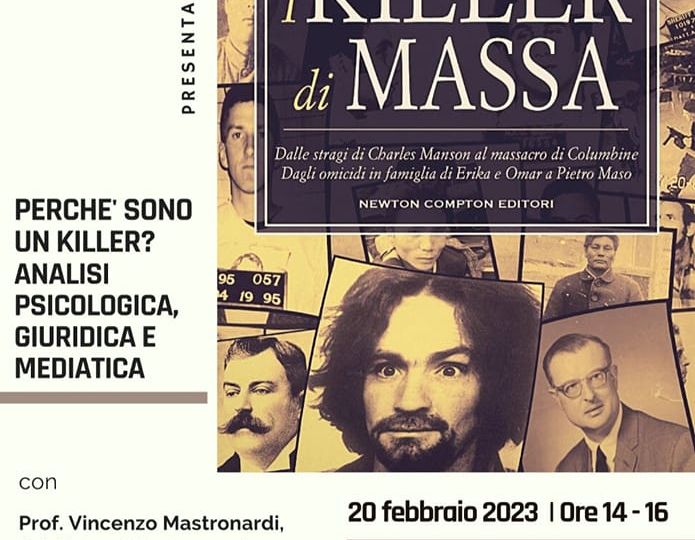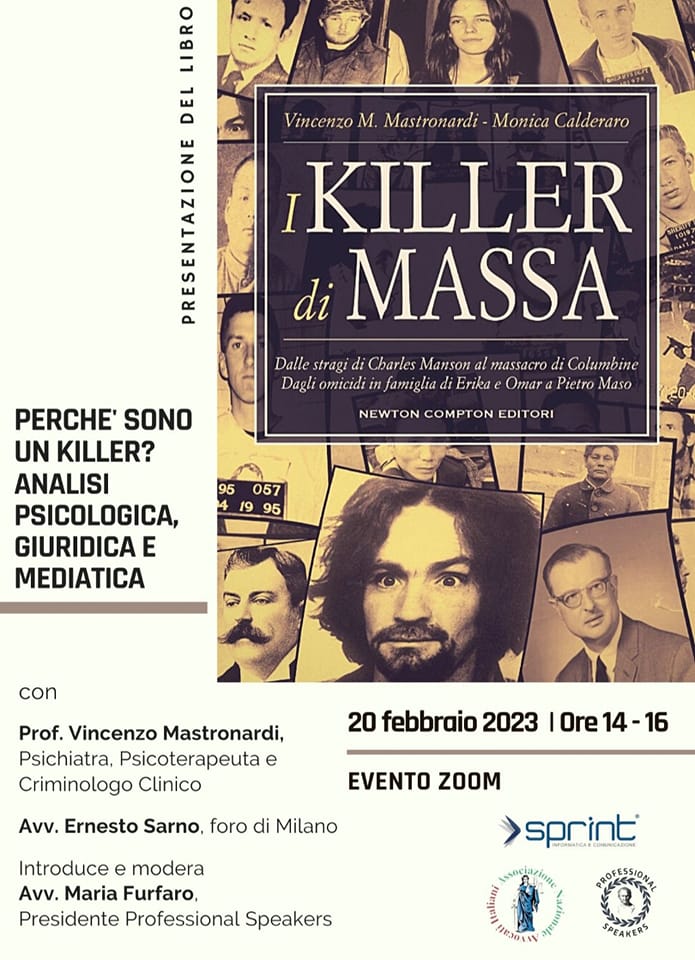

The book by Prof. Vincenzo Maria Mastronardi and Monica Calderaro, “The mass killers”, is very enlightening on the point.
We will have the pleasure of seeing and listening to the famous Psychiatrist, Psychotherapist and Clinical Criminologist, as a speaker at a Webinars organized by Professional Speakers, Anai And Sprint dated February 20 pv as per attached poster. My colleague, Avv. Ernesto Sarno, will also participate in the event.
To give you a taste of the book (which among the numerous cases discussed also mentions that of Pietro Maso, Erika and Omar and Charles Manson), and of what we will discuss at our meeting, I bring you some excerpts.
“The criminal acts committed by the mass murderer (mass murderer), are the expression of a sudden, sudden and compulsive manifestation of “destructive fury” and lead to disastrous consequences. This type of homicide is characterized by anger, hostility and frustration that are sometimes uncontrollable”.
The Multiple Assassins (multiple killers) They are so defined if they commit or attempt to commit at least 2 murders.
In 1979, the FBI (Federal Bureau of Investigation) classified the individuals responsible for multiple homicides based on the victimological circumstances and the methods of execution into 3 groups:
– serial killer
– spree killer
– mass murderer.
The Serial Killer (or serial killer) for the FBI was characterized until a few years ago by the execution of multiple crimes (3 or more victims) with characteristics of monstrosity, spaced out by more or less long temporal segments; this interval is indicated in 7 phases (they are reported in the book). Today all scholars, including the FBI, maintain that if the killer is arrested before the 3rd crime or if other imponderable eventualities prevent him from committing it, 2 murders are sufficient, in different places and with an emotional interval separating them, to justify the name of serial killer. Necessarily, the subject must enter the sphere of a cyclical compulsion to repeat, without being able to stop until he is stopped or he himself ceases to live, due to an accident or, often, suicide following the fragmentation of his own Ego.
The Spree Killer (or compulsive murderer) is the author of 2 or more crimes in different times and places, but consecutive, as if obeying a single logical plan. These crimes have a single linked cause. Usually the spree killer does not know his victims and, since he does not hide his tracks, he often leaves behind a long trail of blood, so he is easily caught.
Spree killers kill randomly and do not worry about being discovered, as they have no vision of their own future.
A good example is shown in the movie “A day of ordinary madness”, starring Michael Douglas, where the protagonist, a man with psychological problems, tries to get home in time for his daughter's birthday party: after an argument with a driver, he begins to commit crimes along his route, until he is killed at the hands of a policeman.
The substantial difference between the “serial” and the “spree” is that the former wants to perpetuate its actions over time, indefinitely, taking care not to leave traces or in any case not to be caught.
He has a vision of the future, and he wants to repeat what has gratified him in a sort of “murder orgasm”, enjoying it to the fullest.
This occurs in the so-called totemic phase, in which, as in the case of Jeffrey Dahmer, they keep parts of their victim's body as if they were heirlooms.
The spree killer does not have these intentions, he kills without any prospect for his future, as if the world or his time would end that day.
He feels no need to run away, to hide what he has done, or to avoid being caught.
The Mass Murderer (mass murderer) kills or attempts to kill several people at the same time in the same place.
The subject does not know his victims, who are mostly chosen randomly.
The latest research and studies carried out in this field maintain that the simultaneous killing of 3 subjects already leads to the classification of mass murderer (Mastronardi and Palermo, 1998 – 2000 – 2021), while for the Federal Bureau at least 4 are necessary, in fact those who kill up to 2 victims are called double killers, while in the presence of 3 victims they are defined triple killer.
To be considered as such, mass murderers do not necessarily have to succeed in killing, the act must be intentional, therefore attempted murders that present the explosive triptych mentioned above are also taken into consideration.
In concrete terms, this criminal commits a massacre, or at least attempts to. At least 4 people should be involved in this massacre (but according to modern theories, less than 4 would be enough).
By convention, terrorist, mafia-related or war-related massacres are excluded, since certain actions are dictated by extrinsic motives and not by intrinsic motivations of the mass murderer, which are typically non-rational.
Therefore, whenever these massacres have a motivation that can be found in reality - which certainly does not make them justifiable - and not only in the psyche of the subject, they are not recognized as massacres carried out by mass murderers. Paradoxically, a massacre in war carried out for personal purposes, that is, with motivations inherent in the perpetrator and not for war purposes, would lead to the classification as an action of a mass killer.
To explain better: the massacre on the Nice seafront, carried out with a bus by a man apparently moved by religious motives, could fully fall within the definition of mass muder, as the criminal was left without a job and had been abandoned by his wife. Practically, a do-it-yourself terrorist, a person who mimics terrorism.
The questions we ask ourselves are:
Is it possible to prevent such destructive acts?
Is it possible to recognize danger signs in advance?
Are there any clues to recognize a serial killer?
How does he behave in the family?
Prof. Mastronardi will answer this and much more during our meeting.
We are waiting for you on the zoom platform!
For information on costs and registration send an email to roberto@sprintsrl.it
Attorney Maria Furfaro

